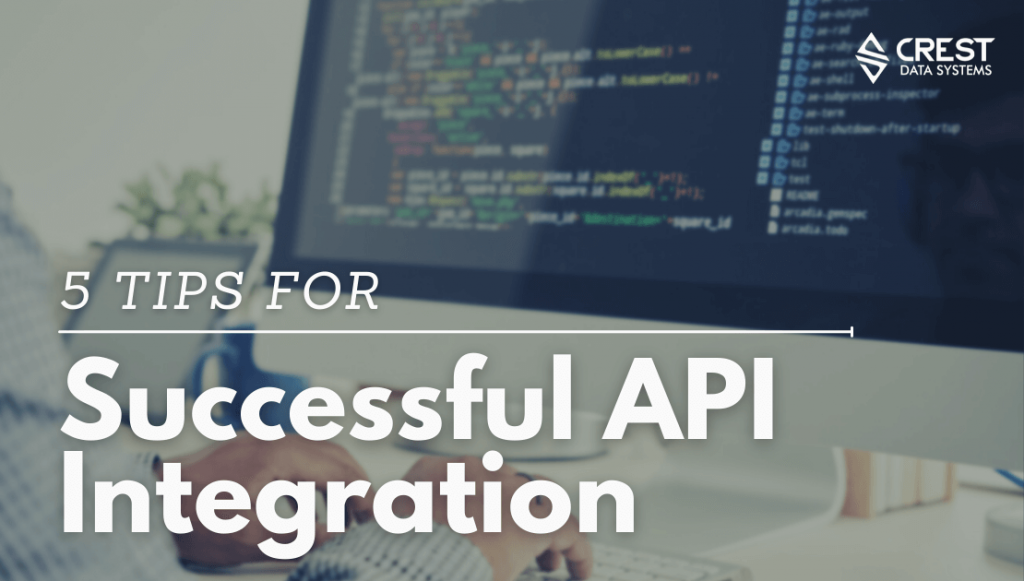5 Tips for a Successful API Integration

Let’s quickly begin with what is an API? An abbreviated definition is, an application programming interface (API) is a connection between separate applications, computers, or programs. It is a type of software interface, offering a service to other pieces of software.
A successful API integration provides many conveniences and benefits, the US government says, understanding the advantages of API production allows you to coordinate with system owners and other stakeholders to modernize the agency’s systems and unlock the sizable potential. Just some of these opportunities are: Efficiency, Partnerships, Personalization, Wider Reach.
As you begin the process to build an API integration, consider the following tips to maximize business and implementation success.
Will it Bring Value to Your Business?
Choosing the right project for your company and overall business strategy is important to consider before dedicating your team’s time and resources. The new integration should help key technologies work together while showcasing your company’s approach to innovation.
A successful API should help you grow your user base and possibly help your organization expand into other verticals previously not tapped. You may want to ask yourself, what is the business case or problem being solved? Does the solution already exist? This initial assessment will help you align business ambitions with your technical efforts and objectives before commitment.
For example, Google Maps API can be added to most websites or applications, from retail, restaurants, IoT, service delivery apps, and much more. The convenience and ubiquitousness of this integration has helped to add to the trust and familiarity of Google’s services. Google Maps has become the standard and prominent map app for most users.
Once all stakeholders are in agreement to proceed, be sure to follow key milestones of the API integrations during its lifecycle against the company top and bottom line and compare with the original goals.
Prepare for Challenges
Similar to a new development project, prepare your team by understanding the most common challenges faced during an API integration.
Complexity
Perhaps the most accepted and common challenge. The alignment of different project components such as benchmarks and goals, stakeholder responsibilities, integrity, compatibility, security all play an integral role in the success of a project. Be sure key members of each team are present and aligned with the details of the integration.
Aside from the complexities from a project management perspective, the technological and development complexities will keep teams up at night. Create a roadmap with milestones and set up a cadence of weekly meetings to understand responsibilities needed from each team and the benchmarks completed. Having clarity on each component during the development process will keep the project timeline on track.
Security
A new API integration can expose endpoints to a wide attack surface, authentication checks should be examined at every function. Consider the sensitive data that may be in object properties and assess how to limit the amount exposed to the client. Security Misconfiguration is a common mistake during development that causes security vulnerabilities. With the array of attacks that could happen, do not rely on clients to perform these safety checks. These types of analysis and scrutiny should be on the development team’s roadmap. Find more resources on OWAMP.
According to a 2021 data breach report by IBM, Data breach costs rose from 3.86 million to 4.24 million (USD), the highest average total cost in the 17-year history of the report.
The report also states that remote work due to COVID-19 increased cost. The average cost was 1.07 million (USD) higher in breaches where remote work was a factor in causing the breach, compared to those where remote work was not a factor.
Now more than ever companies depend on the interconnectivity of applications and platforms. API protocols must prioritize and implement strict security standards during development to ensure the prevention or mitigation of a data breach or compromise.
Lifecycle Management
As API adoption becomes more ubiquitous, teams must provide and maintain solutions over the entire lifecycle of the integration until retirement. This includes but is not limited to documenting, troubleshooting, future proofing, analyzing and managing the health to maintain the integrity of the API integration.
Documentation
Documenting is a crucial step during the development process and necessary as a deliverable at the same time as when the API is ready for launch. Detailed and complete documentation will help development and future API teams alike to successfully work with the API.
Providing comprehensive documentation helps serve as a guide or handbook for teams to reference in case of any questions, reducing the manual support cycles the API development team will need to spend answering queries.
Understanding the importance of this effort during the development of the API will help make the task less daunting in the end. Include this as a parallel workstream during the development process to avoid confusion and missing key points that should be included.
To begin, the documentation should cover an overview, getting started tutorials, authorization and authentication, rate limiting, status and error handling, usage limitation, threshold considerations, data input and output, with best practices and examples. But each integration use case will be different and more applicable topics should be considered and noted during the build to include all the necessary information on how to work successfully with the API.
Test and Retest
Teams must perform integration tests to verify the application works as intended. Proper testing will unveil things that may have been missed or not predicted. Errors and possible unintended input and output scenarios that will negatively impact the performance of the integration should emerge and be resolved now during the development stage.
Integration testing should be conducted to evaluate the compliance of a system or component with specified functional requirements and most importantly to determine if it meets the expectations for functionality, reliability, performance, and security and achieve the desired results.
API testing typically involves unit testing, functional testing, load testing, runtime error detection, security testing. Once these tests are complete, as best practice, retest before launch and deployment to ensure integration success.
Track Success
Development and project management teams should track different KPIs upon launching a new API integration. Involve stakeholders to understand and monitor metrics to analyze the performance to see if milestones are being met and if there are any issues that can be resolved, mitigated, or the integration improved upon with additional features.
From a business perspective, include sales and marketing teams to track customer adoption and feedback, analyze customer data that could point to new and different industry trends, leads and sales opportunities. A new API integration in the marketplace may yield and collect valuable business insights that can be strategic for your company’s future.
The reputation of your company and its teams is represented in the success of the API integration. Tracking goals met during development, at launch and afterwards should be in the roadmap. Ensure all teams have visibility on the performance and where improvements can be made during the entire lifecycle of the API.
Next steps
Crest Data Systems has worked with Fortune 500 companies as well as some of the world’s most innovative companies and hottest startups to streamline work processes so teams can perform at their highest level.
Contact us to learn more about our solutions and our broad range of professional services that encompass consulting, implementation, upgrades, migration, health checks, and see how we can help you today.

AUTHOR –
TUAN NGUYEN
Tuan is a Product Marketing Manager with 8+ years of industry experience in large Enterprise technology companies and start-up. He is passionate about technology marketing and has experience in Cybersecurity, Cloud Security, and Data Center Networking.

